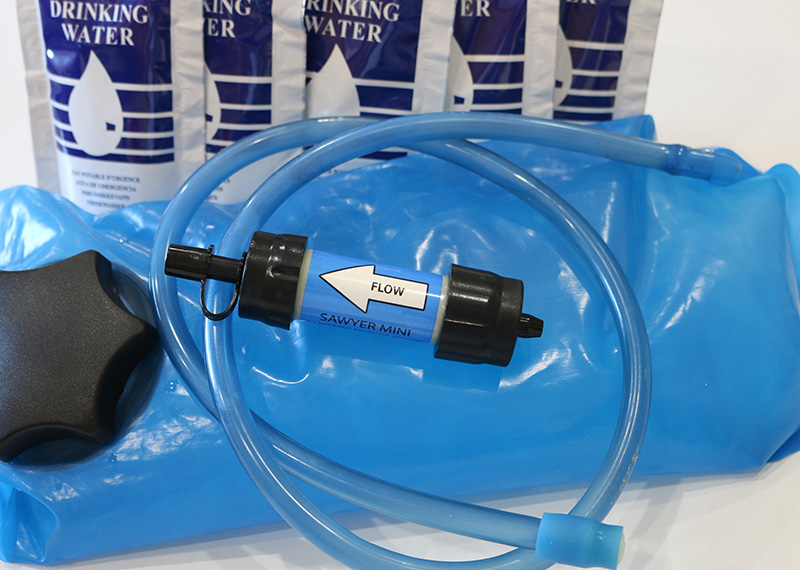 Water Treatment
Water Treatment
THE POINT
No matter how much water you have stored, eventually you are going to run out. In an emergency situation, you may find yourself without clean and safe drinking water.
Knowing how to find and treat additional sources of water will help you "be ready" for an emergency. Remember to always start with the cleanest water you can find.
DO THIS
- Learn the three steps of treating water and how to and it safe for drinking, cooking, first-aid, and hygiene..
- Learn about different kinds of water filters and for what situations they are best suited.
- Learn different methods of purifying water and when to use them.
- Talk to your local emergency preparedness or outdoor retailer and purchase water treatment supplies for your disaster supply kit and for at home use.
- BONUS: Purchase a large capacity water filter for home that will filter at least to a 0.3 or 0.2 micron size.
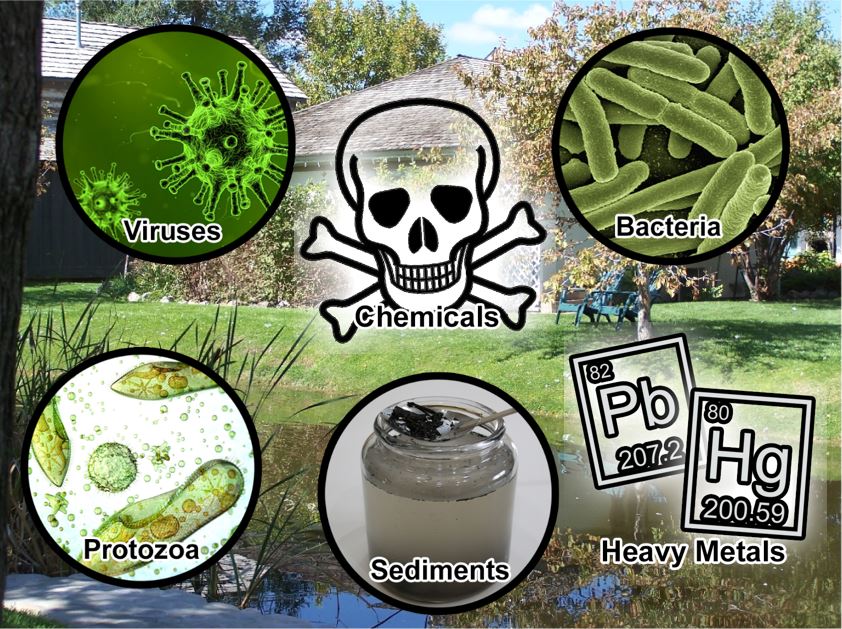
Contamination in Water
Contamination in Water
Water can be contaminated with organisms such as protozoa (about 3 microns in size or more) like Cryptosporidium and Giardia. These relatively larger microorganisms can be easily filtered with a quality filter, but some chemical purification processes may not be potent enough to kill them.
Water can also be contaminated with smaller bacteria (0.4 microns in diameter and up) like E.coli, Salmonella, and Cholera. Most of these can be filtered with a high quality water filter, but it is recommended to do a purification process as well.
Smaller still are viruses (about 0.01 microns) like Rotavirus, Hepatitis A and E. Dangerous viruses are generally not found in North American water systems. Very few water filters filter out something as small as a virus, but most any effective purification process will kill them.
Contamination can also be from chemicals and heavy metals. Some of it is naturally occurring in water, and some can come from industrial or agricultural runoff. These can only be filtered out of the water.
Finally, sediment contamination (dirt, sand, organic matter) can be stirred up from the movement of the water or by disturbing the bottom of streams or other outdoor water sources. These can be removed during the pre-filter and filter processes.
Whatever your source of water, don’t assume the water is clean, just because it’s flowing and looks clean. Treat all outside water sources with caution. Even if it looks clean – TREAT IT! If there is any question as to the safety of your water, from inside or outside sources, treat it.
You can’t afford to get sick, especially during an emergency situation.
Treatment
Water treatment is a three part process. All are necessary, especially if you are unsure as to the quality of your water source and what is contaminating it.
Before anything else, always choose the CLEANEST water you can find.
- Pre-filtration
- Filtration
- Purification
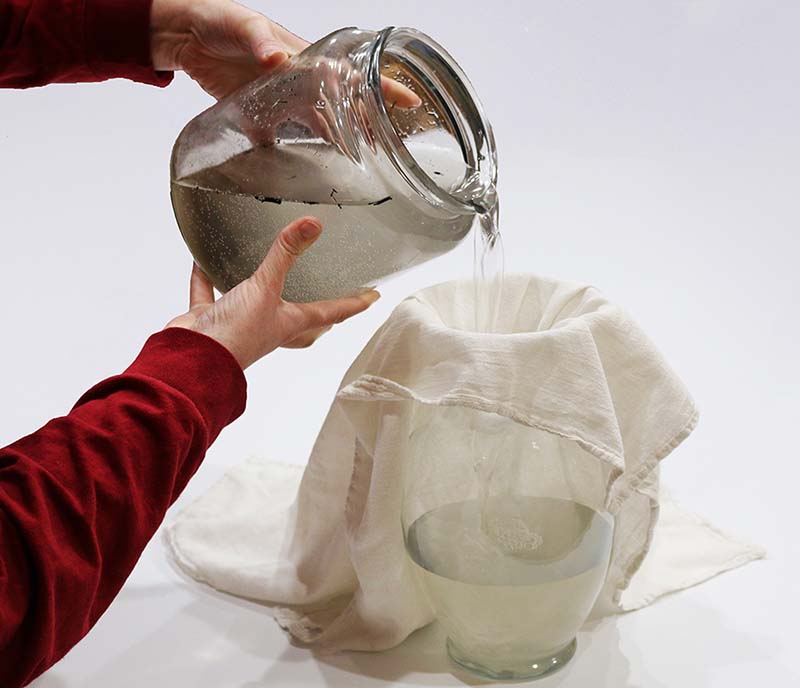
Pre-Filter Water
Pre-filtration
Pre-filtration is the first process. This gets the large particles, the "chunks" out and lengthens the useful life of your filter. Your filter can easily filter out these large, visible particles, but your filter will clog much sooner. Save money and save your filter by pre-filtering.
Allow suspended particles to settle to the bottom of the container or collect them at the top to be skimmed off. Then pour the water through cloth, cotton, cheese cloth, or a t-shirt. Anything that is clean to pour the water through. Have a container to catch the pre-filtered water. Remember, this is only pre-filtered water. It is not yet ready for drinking.
The next two processes can be done in either order depending on your situation.
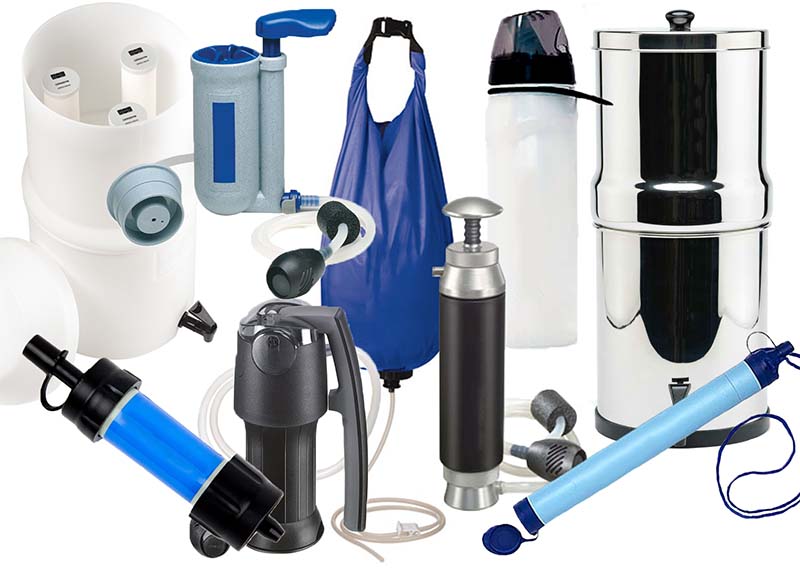
Filtration
Filtration is a physical barrier that traps particles and contaminants as water passes through. The lower the micron level of the filter, more smaller particles will be filtered out. There are many different options, levels of quality, sizes, types, and styles of water filters. Depending on the filter, they can remove chemicals, sediments, protozoa, bacteria, and heavy metals. Most filters do not remove viruses, but we don’t have an issue with viruses in our water in North America. All filters have a suggested water capacity for replacement. How well you pre-filter your water will determine if your filter's life span will fall short of or exceed it's suggested replacement time. When water flow greatly diminishes or pumping gets extremely difficult, it is time to dispose of and replace or clean your filter. Refer to manufactures directions for replacement or cleaning. Consider your needs, abilities, number of people you will be supplying water for, potential sources of water, and potential contaminants when deciding which water filters to purchase.
- Gravity fed filters use gravity to pull the water through the filter. they tend to be larger and sit on a tabletop or hang. They are slower than other filters but do not require constant attention. They work well for at home, work, or camping with a group.
- Pump filters are usually what people think of with water filters. The hand pumping action pushes water through the filter. It is faster than gravity fed and can be used with a small group of people. this is the style you would want in a group emergency evacuation kit.
- Straw filters are meant to be used by only one person. One end of the filter goes in the water while the user sucks on the other end like a straw and draws the water through the filter. Some of these can also be used in the line of a hydration bladder for filtration on the go. To be most effective, straw filters need to have their source water purified first.
- Water bottle filters are similar to straw filters in that the user draws the water through the filter while sucking on the mouthpiece. The source water is contained in the bottle around the filter. To be most effective, these too need to have their source water purified first.
- Ceramic and fiber glass filters use different media to block the particles as the water pass through them. Microscopic pores in the materials allow the water to pass while catching the contaminants. Ceramic Filters have the added benefit of being able to be rinsed off to prolong their usefulness. Fiberglass and other types of filters need to be replaced periodically according to manufacturers’ instructions. Gravity fed, pump, straw, and water bottle filters usually use some combination of these materials to filter water.
- Reverse osmosis is a process used in your home's pressurized in-line system. It will work if there is pressure in the water line. Most do not require electrical power unless you need an electrical pump.
- Activated carbon absorbs chemicals and dissolved minerals as the water passes through. It is often used to make tap water taste better and to remove bad odor. Activated carbon filters by themselves are NOT adequate for removing harmful microorganisms. Some gravity fed or pump filters use activated carbon as a part of their filtration process to aid in removing chemicals and dissolved minerals while improving taste.
Avoid “home made” filters unless there is no other option. There is a lot of misinformation about how to make a filter yourself. If you choose, you can learn the principles so you know how if you need to, but use it as a last resort. Spend the money now to get quality filters for disaster supply kits and for your other emergency needs. Ask local outdoor or preparedness dealers to help you find which water filters are right for your preparedness needs and budget.
Purification
Purification involves either a heat, UV light, or chemical process that kills the organisms living in the questionable water. Most purification processes do not remove anything from the water.
- Heat purification processes require fuel, which is possibly a scarce commodity in an emergency.
- A rolling boil (recommended) for three minutes at Utah’s average elevation will kill all organisms in the water. After the three minutes, let the water cool before using. Higher elevations will require a longer boiling time. A lid helps water boil faster and prevents loss from evaporation. Remember, boiling does not remove anything from the water, it just kills it. Sediments, chemicals, heavy metals and salts remain if not already filtered out.
-
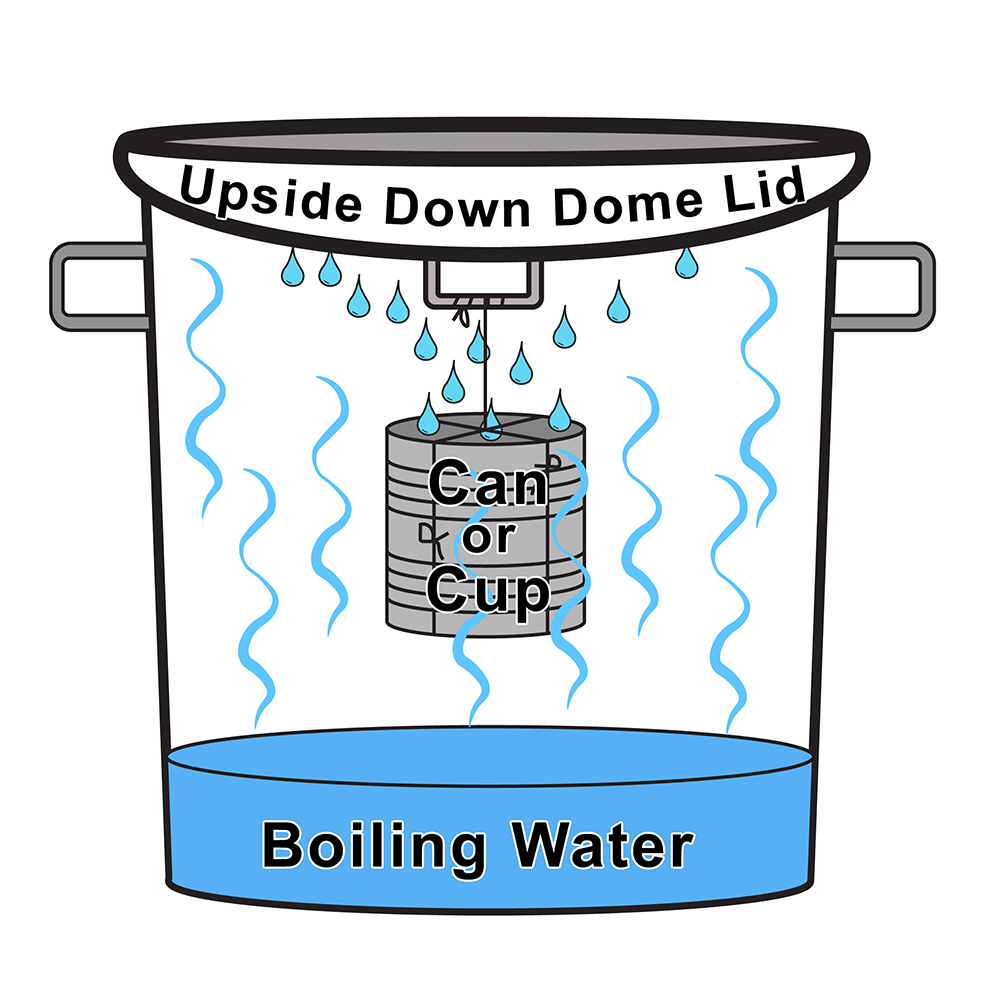
Basic Water Distiller
Distilling is more involved, but does a better job than boiling alone because it removes the water from the contaminants. While boiling will kill most microorganisms in water, distillation will remove heavy metals, salts and most other chemicals. Distillation involves boiling water and then collecting only the vapor that condenses. The condensed vapor will not include salt or most other impurities.
Easy distiller: Fill a pot halfway with water. Tie a cup to the handle on the pot’s concave lid so that the cup will hang right-side-up when the lid is upside-down. Make sure the cup is not dangling in the water. Boil the water for 20 minutes. The water that drips from the lid into the cup is distilled.
- Ultra violet (UV) light purification or sunlight can also be used to purify water.

UV Water Purification in a 2 Liter Bottle
- There are commercial products available that use UV light, but they require batteries. UV light pens can be used for small quantities of water and are popular with travelers for use in foreign countries at restaurants when discretion is needed. It’s not practical for large quantities of water.
- UV sunlight and a clear, plastic, two liter soda pop bottle can be used to purify water. It takes time and a clear, sunny day, but it works. Know that it is not very effective with cloudy water. Pre-filter the water first. The bottle be clear plastic and no more than two a liter size, but you can use smaller. Lay the bottle perpendicular to the sun for the greatest sunlight penetration. It is more effective if the bottle is laid on a reflective surface like foil or a mirror. Wait six hours on a sunny day or two full days if it's partly cloudy.
- Chemical purification does not remove anything from the water; it only kills what’s in it. Be sure to closely follow manufacturer’s directions in how to use their products.
- Iodine has been used for chemically treating water for many years. It has a 4 to 5 year shelf life in unopened bottle, 1 year in an opened bottle, and is susceptible to heat, light and moisture. It comes in tablets or drops. Iodine kills all microorganisms but larger protozoa, so if you are unaware of what's in the water, be sure to filter it as well. Do not use iodine longer than a few weeks straight. It is intended for short term emergency use only. Do not use it if you are pregnant, have an allergy to iodine or have a thyroid problem.
 Sodium hypochlorite (liquid bleach) has a six month to one year shelf life. It rapidly begins to break down into nothing more than salt and water, so don't purchase a large supply unless you plan on using it and rotating it. Use only pure bleach, not scented and not colored. Know also that it may not be effective against larger protozoa by itself.
Sodium hypochlorite (liquid bleach) has a six month to one year shelf life. It rapidly begins to break down into nothing more than salt and water, so don't purchase a large supply unless you plan on using it and rotating it. Use only pure bleach, not scented and not colored. Know also that it may not be effective against larger protozoa by itself.
To use, add about eight drops per gallon of water. The Red Cross website says use 16 drops, some bleach manufactures say use six drops. It depends on the potency of your bleach. After adding the drops, stir and wait 30 minutes. If there is not a faint smell of bleach, do about eight more drops and wait another 30 minutes. If no faint bleach smell, the water is too contaminated for drinking and should be disposed of.
Please note: Calcium hypochlorite (dry bleach) is NOT the same thing as sodium hypochlorite (liquid bleach). Some people want to use calcium hypochlorite instead because it has a longer shelf life than liquid bleach. Calcium hypochlorite is difficult to use to get the correct concentrations in your drinking water. Too little does not effectively treat the water and too much will make you sick or worse. You need to use pool water testing equipment to get the correct parts per million. For this purpose calcium hypochlorite is not recommended. If you insist, talk to the manufacturer about its proper use in drinking water purification. Additionally, it may not be effective against all protozoa by itself.
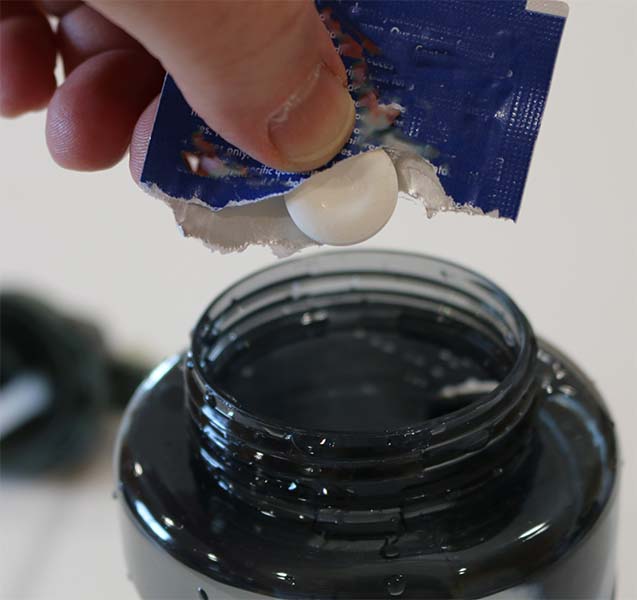
Water Purification Tablet
- Chlorine dioxide (recommended) has a 4 to 5 year shelf life and comes in liquid or tablets. The liquid form treats water faster (about 30 minutes), but it’s a little more difficult to mix the two reacting chemicals together and let them sit for 15 minutes before pouring them in the water than to just drop in a tablet which requires four hours of processing. If this is your preferred method of water purification, use the liquid for at home treatments and the tablets for disaster supply kits and backpacking.
Chlorine dioxide is iodine and chlorine free. It works by releasing nascent oxygen, which is a strong oxidant and a powerful germicidal agent into the water. It has greater pathogen killing power than iodine or chlorine, but is much safer for continual use as long as it is used in correct dosages in the drinking water. Unlike iodine, chlorine dioxide does not discolor water, nor does it give water an unpleasant taste. It's often used to improve the taste of water.
12 Areas: Water
Click Here
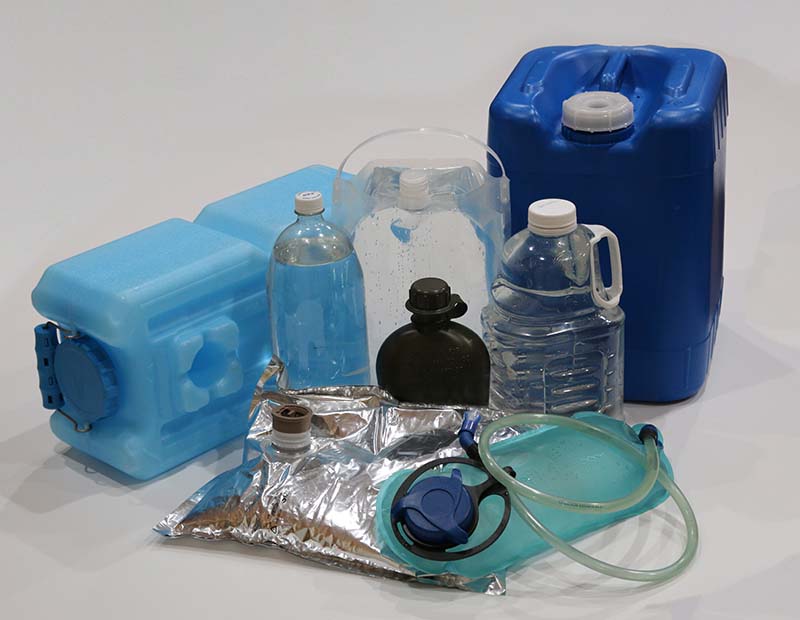
Other Sources of Water
Click Here

Disaster Supply Kit: Water
Click Here
